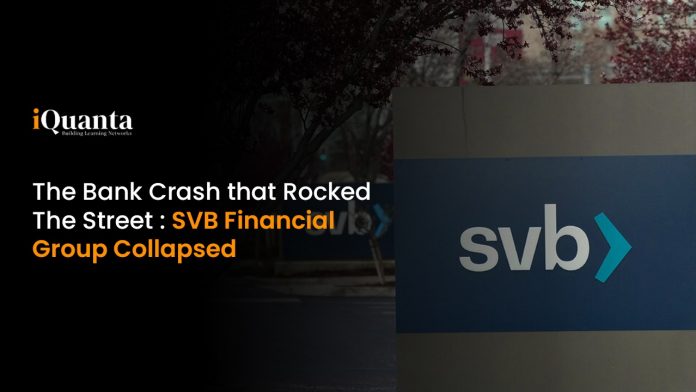SVB Financial Group Collapsed
SVB Financial Group bought some of the safest assets in the world of finance. How could it possibly have failed in two days?
Here are some questions and answers to help explain what happened in the bank of the silicon valley – or ‘The Valley‘ as the people around the world call it.
But before diving headfirst into the problem we need to know what safe assets and conservative investing is – suppose you buy some stocks of some federal assets – although the scope of growth on these assets do not produce some outlandish figures – at the same time – it ensures a steady flow of revenue and the risk of tanking of those assets, since they are directly aligned with the interest of the government or the federal authority – they enjoy certain insulations and immunity. Conservative approach is the policy that a company follows to generate revenue with minimal risk factor.
CAT 2023 Prep Group. Join Here!
Trouble in Paradise?
SVB Financial is the parent company of Silicon Valley Bank, which counts many startups and venture-capital firms as clients. During the pandemic, those clients generated a ton of cash that led to a surge in deposits. SVB ended the first quarter of 2020 with just over $60 billion in total deposits. That skyrocketed to just shy of $200 billion by the end of the first quarter of 2022. This rapid rise and growth of the company attracted users or consumers in a sudden sharp growth hike mainly within the period of 2021, as the world was slowly recovering from the COVID blow and suffering from war based inflation and supply chain bottlenecks – as embargoes continued interfering in world economy.
SVB Financial bought tens of billions of dollars of seemingly safe assets, primarily longer-term U.S. Treasuries and government-backed mortgage securities. SVB’s securities portfolio rose from about $27 billion in the first quarter of 2020 to around $128 billion by the end of 2021.
These securities are at virtually no risk of defaulting. But they pay fixed interest rates for many years. That isn’t necessarily a problem, unless the bank suddenly needs to sell the securities. Because market interest rates have moved so much higher, those securities are suddenly worth less on the open market than they are valued at on the bank’s books. As a result, they could only be sold at a loss.
SVB’s unrealized losses on its securities portfolio at the end of 2022—or the gap between the cost of the investments and their fair value—jumped to more than $17 billion.
The sins just crept up your back
At the same time, SVB’s deposit inflows turned to outflows as its clients burned cash and stopped getting new funds from public offerings or fundraisings. Attracting new deposits also became far more expensive, with the rates demanded by savers increasing along with the Fed’s hikes. Deposits fell from nearly $200 billion at the end of March 2022 to $173 billion at year-end 2022.
And that is accelerating this year: As of Jan. 19, SVB was forecasting its deposits would decline by a midsingle-digit percentage in 2023. But their expectation as of March 8 was for a low-double-digit percentage decline.
On Wednesday SVB said it had sold a large chunk of its securities, worth $21 billion at the time of sale, at a loss of about $1.8 billion after tax. The bank’s aim was to help it reset its interest earnings at today’s higher yields, and provide it with the balance-sheet flexibility to meet potential outflows and still fund new lending. It also set out to raise about $2.25 billion in capital.
Why it didn’t work?
Following that announcement on Wednesday evening, things seemed to get even worse for the bank. The share-sale announcement led the stock to crater in price, making it harder to raise capital and leading the bank to scuttle its share-sale plans, The Wall Street Journal has reported. And venture-capital firms reportedly began advising their portfolio companies to withdraw deposits from SVB.
On Thursday, customers tried to withdraw $42 billion of deposits—about a quarter of the bank’s total—according to a filing by California regulators. It just simply ran out of cash and assets to liquidate. Being federal owned assets – the liquidation is subjected to a lot of legal red tapes – making it practically impossible to milk the cash cow that they were rearing. In a way – the safest bet turned into their biggest liability.
Many of the bank’s deposits are sizable enough that they don’t carry Federal Deposit Insurance Corp. protection. SVB said it estimates that at the end of 2022 the amount of deposits in its U.S. offices that exceed the FDIC insurance limit was $151.5 billion.
The FDIC said in a statement on Friday that customers will have full access to their insured deposits no later than Monday morning. The FDIC said it hadn’t yet determined the current amount of uninsured deposits. But it said that uninsured depositors will get an advance dividend within the next week. For the remaining amounts of uninsured funds, those depositors will get something called a “receivership certificate,” and as the FDIC sells off the assets of SVB, they may get future dividend payments.
Impact on Other Bank Stocks
Already rattled by the failure of Silvergate Capital, whose own problems started with crypto but also reflected a portfolio of government debt whose value was depressed by higher rates, investors are selling bank stocks across the board. Stocks of other midsize lenders such as First Republic Bank and Signature Bank were halted on Friday morning.
The impact of higher rates on banks’ securities isn’t limited to SVB. Across all FDIC banks, there were about $620 billion worth of unrealized losses in securities portfolios as of the fourth quarter.
Conclusion
One of the big questions coming out of this will be which banks misjudged the match between the cost and lifespan of their deposits and the yield and duration of their assets. This is very different from the questions about bad lending that haunted the 2008 financial crisis.
As money flowed into banks during the pandemic, buying the shortest-term Treasuries or keeping the money in cash would have insulated them from the risk of rising interest rates. But it also would have depressed their income. Banks’ reach for “safe” yield may be what haunts them this time around.
With Elon Musk casually tweeting over overtaking the bank at the crosshairs to financial pundits like Elaine McPherson stating it as a huge blow to both the fed and the market that thrives on fed- corporate co operation – the future of SVB is unclear – and what it does to salvage its reputation will be closely scrutinized as it seemingly has triggered a domino effect – with NY based Signature Bank biting the dust.
iQuanta guides you in your CAT preparation from the very basics. For high content relevancy and 24*7 doubt solving, enroll for iQuanta’s CAT 2023 Course. Click on the link below to check out the details.


